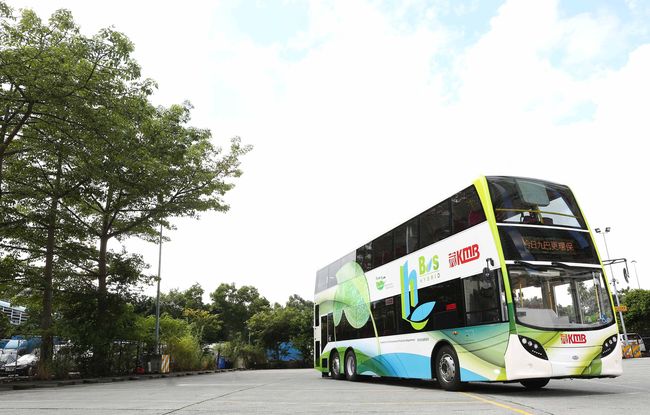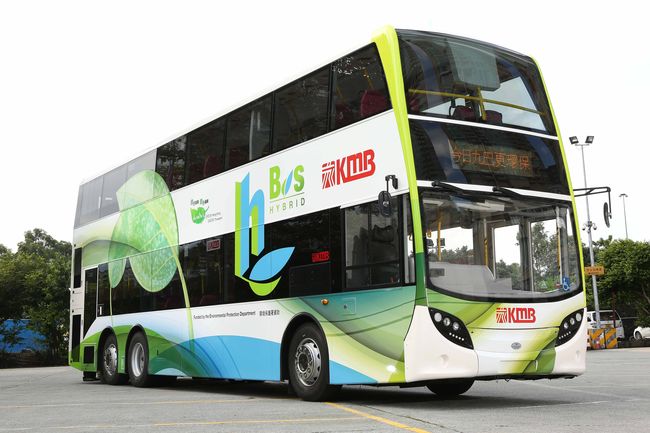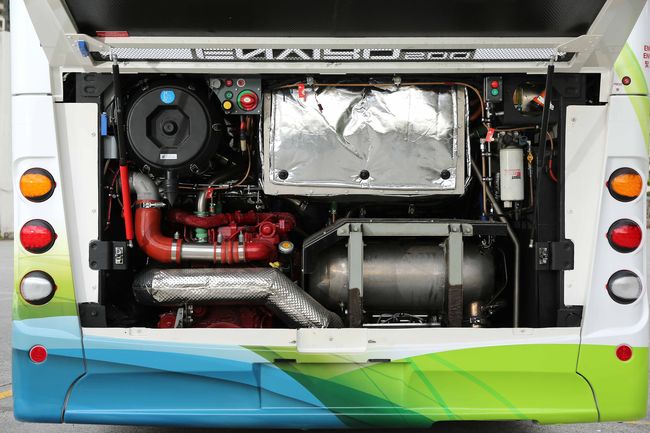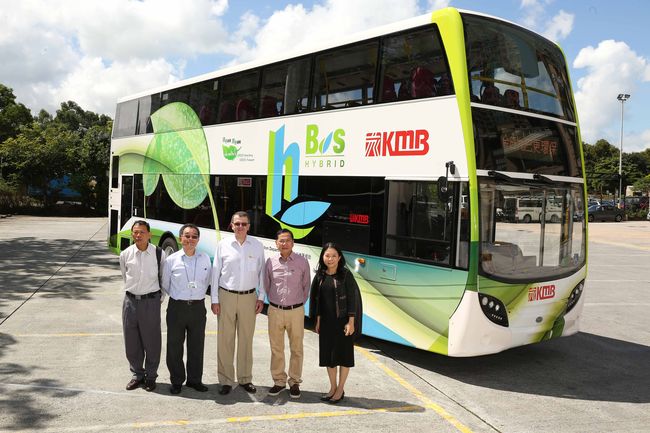2014-09-13
Co-developed by KMB and the bus manufacturer for three years and
funded by the Environmental Protection Department (“EPD”), “hBus”,
Hong Kong’s first double-deck bus powered by a Euro VI hybrid
engine, has joined the KMB fleet after delivery earlier this month.
The bus is expected to enter passenger service on three urban
routes starting the fourth quarter this year.
KMB will arrange for hBus to go through the Transport
Department’s “type approval test” and licensing procedures before
it enters passenger service. Initially, “hBus” will run on three
urban routes: 1A [Sau Mau Ping (Central) ←→ Star Ferry], 104
[Kennedy Town ←→ Pak Tin] and 619 [Shun Lee ←→ Macau Ferry].
This hBus can boast three “firsts in Hong Kong” – the first
hybrid double-deck bus, the first double-deck bus equipped with a
Euro VI engine, and the first double-deck bus with the
air-conditioning system powered by electricity. It is expected that
hBus can achieve fuel savings of up to 30%, while emissions of
major pollutants are reduced (e.g. particulate matter by 50% and
NOx by 80%), when compared to Euro V double-deck buses.
In April 2011, EPD applied to the Legislative Council Finance
Committee for a funding of $33 million to subsidize franchise bus
companies to purchase 6 hybrid buses for trial in Hong Kong and KMB
takes up 3 of them, each valued at HK$5.5 million. The other two
hybrid buses will be delivered to Hong Kong later this year to join
the KMB fleet.
What distinguishes “hBus” from a regular 12-metre, 3-axle
air-conditioned double-deck bus is its driveline system, whereas
the other structures and appearance look alike. The “hBus” is
equipped with a “Hybrid Series” driveline system and a generator
driven by diesel engine, supplying electricity to drive an electric
motor that powers the axles for movement at a stable speed.
Although the Euro VI diesel engine is smaller (6,700cc), the power
is adequate given the matching of electric power. The bus will
close the diesel engine down and automatically switch to electric
power when it encounters traffic congestion or runs at a slow
speed, thus achieving “zero emissions”. Given this, this bus is
suitable for urban roads. The regenerative braking system captures
the otherwise wasted braking energy and stores it in the batteries
(16 modules of lithium iron phosphate batteries), making the bus
more environmentally efficient.
“It is appropriate that ‘hBus’ operates on urban routes, as its
environmental effects will be maximized. Traffic in the urban area
is often very busy and buses have to travel slowly and make
frequent stops, which consumes more fuel. As regards ‘hBus’, the
smart controller will close the diesel engine down in such
circumstances and the bus will be powered by electricity, lowering
emissions. The steering and air-conditioning systems will not be
affected and the bus’s operation will be even quieter,” said So
Hing Shun, KMB’s Assistant Principal Engineer (Operations).
Associate Dean, School of Energy and Environment and Director of
Ability R&D Energy Research Centre, Hong Kong City University,
Dr. Michael Leung said, “In addition to considerably reducing
roadside emissions, the hybrid bus can also improve energy
efficiency by capturing the otherwise wasted braking energy and
storing it in the batteries.”
Director of Energy & Environmental Policy Research Unit and
Associate Professor of Department of Management Sciences, Hong Kong
City University, Dr. William Chung said, “Equipped with the Euro VI
engine, the PM2.5 emission performance of the hybrid bus is better
than that of buses equipped with the Euro V engine. This helps to
improve roadside air quality.”
Principal Lecturer of School of Biological Sciences, University
of Hong Kong, Dr. Billy Hau Chi-hang said, “We anticipate that
‘hBus’ equipped with the Euro VI hybrid engine can start passenger
services soon. Road users can expect to breathe fresher air while
passengers can look forward to quieter journeys.”
In this 24-month trial period, KMB will exchange views with EPD
monthly on the trial performance of “hBus”, including emissions
data, fuel efficiency and other performances.
The emission performance of “hBus” equipped with the Euro VI
engine is expected to be better than the Euro V engine, as shown
below:
Emissions
Euro
VI Engine
(g/KWh)
Euro V
Engine
(g/KWh)
% of
Decrease
Hydrocarbons
(HC)
0.13
0.46
↓72%
Particulate matter
(Pm)
0.01
0.02
↓50%
Nitrogen oxides
(NOx)
0.4
2.0
↓80%
Information of hBus
Bus Model
Alexander Dennis
(ADL)
Enviro 500H 12M
Air-conditioned Bus
Length/Width/Height
12000 mm / 2550 mm /
4398 mm
Engine Type
Cummins ISB Euro VI
6.7L diesel engine
BHP
280
kw
Traction
Generator
3-phase 640VAC
Induction Generator
Traction Motor
3-phase 600V/160 KW
Induction Motor
Battery
640V 11.2 KWh
Lithium Iron Phosphate Battery
Expected Passenger
Capacity
Upper-deck
Seating:51
Lower-deck
Seating:29
Standees:44
Total:124


This KMB hBus can boast three “firsts in Hong Kong” – the first
hybrid double-deck bus, the first double-deck bus equipped with a
Euro VI engine, and the first double-deck bus with the
air-conditioning system powered by electricity.

Although the Euro VI diesel engine is smaller (6,700cc), the power
is adequate given the matching of electric power.

KMB Operations Director Mr. Owen Eckford (third left), Corporate
Affairs Director Ms. Vivien Chen (first right), Assistant Principal
Engineer (Operations) Mr. So Hing Shun (second left) took a photo
with Chief Transport Officer of Transport Department Mr. Vincent
Fan (second right) and Environmental Protection Officer of EPD Mr.
Charles Wu (first left) in front of the new “hBus”.